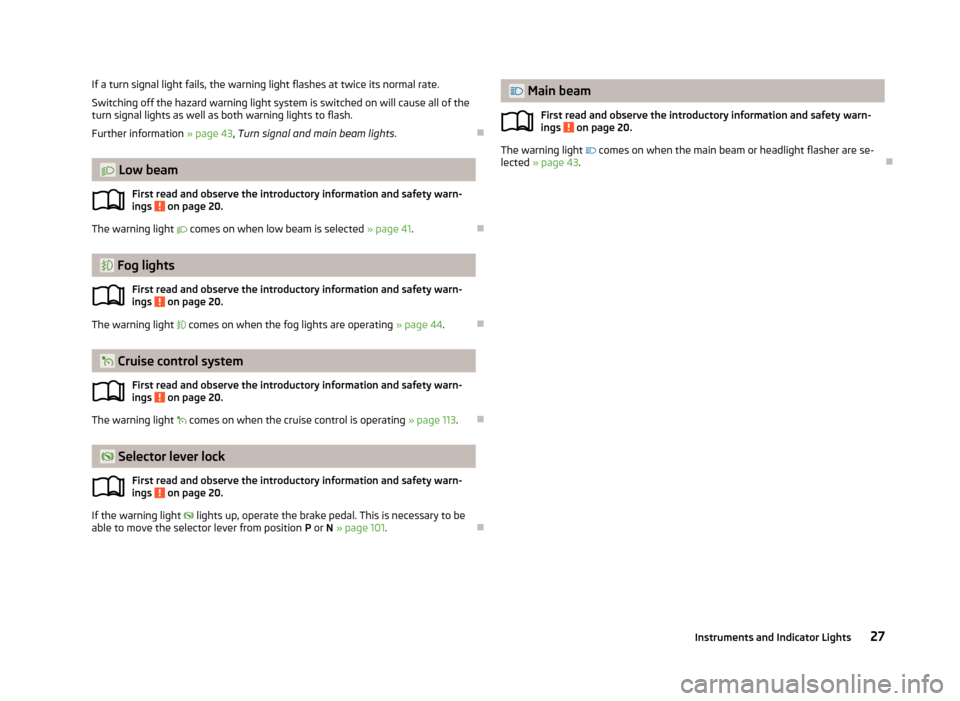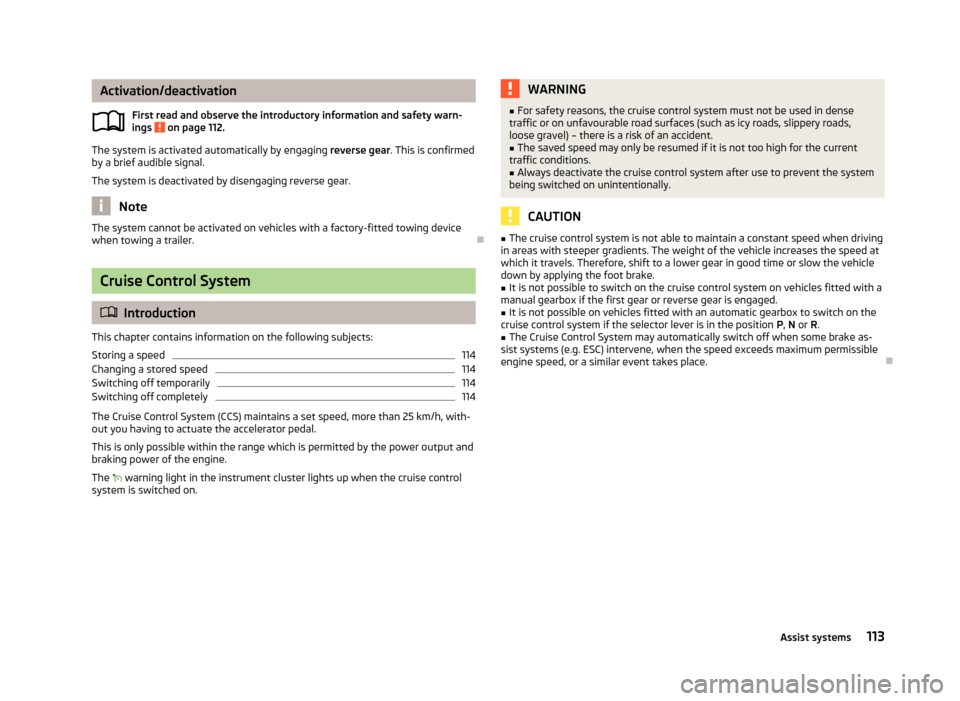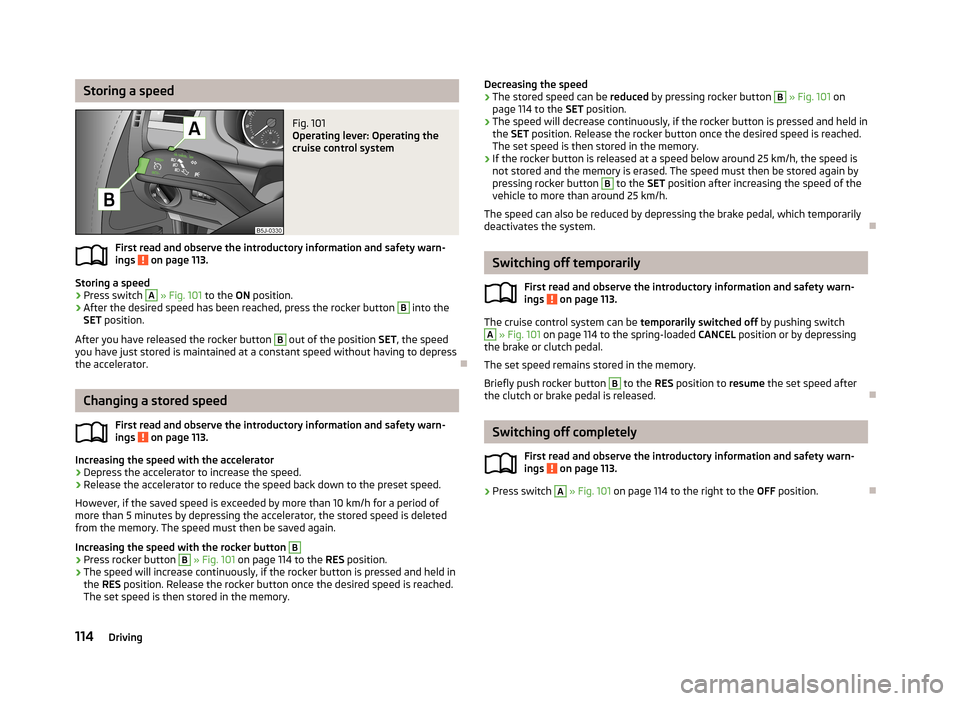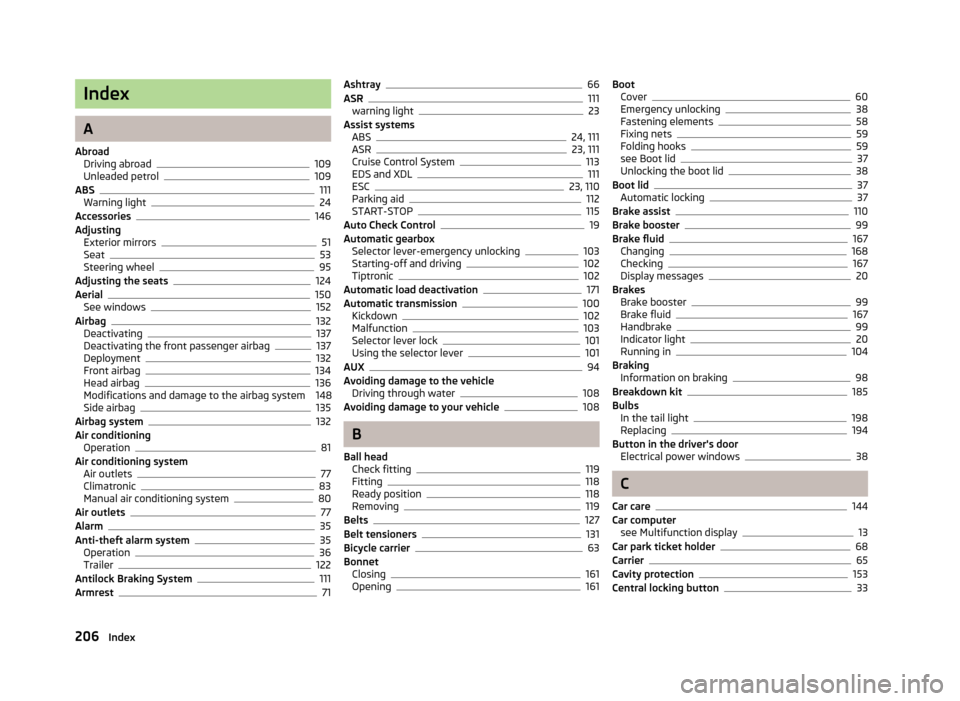2013 SKODA ROOMSTER cruise control
[x] Cancel search: cruise controlPage 6 of 219

Table of Contents
Materials defect liability and ŠKODA warranty for
new cars5
Mobility warranty and ŠKODA extended
warranty
6
Abbreviations
Operation
Cockpit
9
Overview
8
Instruments and Indicator Lights
10
Instrument cluster
10
Multifunction display (MFD)
13
Service Interval Display
16
MAXI DOT display
18
Warning lights
20
Unlocking and locking
28
Unlocking and locking
28
Central locking system
31
Remote control
34
Anti-theft alarm system
35
Luggage compartment lid
37
Electrical power windows
38
Lights and visibility
41
Lights
41
Interior lights
46
Visibility
47
Windscreen wipers and washers
48
Rear window
51
Seats and stowing
52
Front seats
52
Rear seats
54Head restraints56Boot57
Variable loading floor in the luggage
compartment (Estate)
61
Bicycle carrier in the luggage compartment
63
Roof rack system
65
Useful equipment
65
Storage compartments
68
Praktik
73
Heating and air-conditioning
77
Heating, ventilation, cooling
77
Heating
78
Air conditioning system (manual air conditioning system)
80
Climatronic (automatic air conditioningsystem)
83
Communication and multimedia
86
Universal telephone preinstallation GSM II
86
Voice control
91
Multimedia
92
Driving
Starting-off and Driving
95
Steering
95
Starting and stopping the engine
96
Brakes
98
Manual gear changing and pedals
99
Automatic transmission
100
Running in
103
Economical driving and environmental
sustainability
104
Avoiding damage to your vehicle
108
Driving abroad
109
Assist systems
110
Brake assist systems
110
Parking aid
112Cruise Control System113START-STOP115
Towing a trailer
117
Towing device
117
Trailer
120
Safety
Passive Safety
123
General information
123
Correct seated position
124
Seat belts
127
Using seat belts
127
Inertia reels and belt tensioners
130
Airbag system
132
Description of the airbag system
132
Airbag overview
133
Deactivating airbags
136
Transporting children safely
139
Child seat
139
Fastening systems
141
General Maintenance
Car care
144
Service intervals
144
Services, modifications and technical
alterations
146
Washing your car
149
Taking care of your vehicle exterior
150
Taking care of the interior
154
Inspecting and replenishing
157
Fuel
157
Engine compartment
159
Engine oil
163
Coolant
1653Table of Contents
Page 23 of 219

Note■Warning messages shown in the MAXI DOT display must be confirmed with but-
ton B » Fig. 7 on page 18 to call up the main menu.■
As long as the operational faults are not rectified, the symbols are always indi-
cated again. After they are displayed for the first time, the symbols continue to be
indicated without any extra messages for the driver.
Warning lights
Introduction
This chapter contains information on the following subjects:
Handbrake
20
Brake system
20
Seat belt warning light
21
Alternator
21
Door open
21
Engine oil
21
Coolant
22
Power steering
23
Electronic Stability Control (ESC)
23
Traction Control System (ASR)
23
Anti-lock brake system (ABS)
24
Rear fog light
24
Bulb failure
24
Exhaust inspection system
24
Glow plug system (diesel engine)
24
ECU fault light (petrol engine)
25
Diesel particulate filter (diesel engine)
25
Fuel reserve
25
Airbag system
26
Tyre pressures
26
Windscreen washer fluid level
26
Traction control (TCS) switched off
26
Turn signal system
26
Low beam
27 Fog lights27 Cruise control system27
Selector lever lock
27
Main beam
27
The warning lights show certain functions/faults and may be accompanied by au-
dible signals.
WARNING■ If illuminated warning lights and the corresponding descriptions and warn-
ing notes are not observed, this may result in severe injuries or major vehicle
damage.■
The engine compartment of your car is a hazardous area. There is a risk of
injuries, scalding, accidents and fire when working in the engine compart-
ment, e.g. inspecting and replenishing oil and other fluids. It is essential to ob-
serve safety notes » page 159, Engine compartment .
Handbrake
First read and observe the introductory information and safety warn-
ings
on page 20.
The warning light
comes on if the handbrake is applied. An audible warning is
also given if you drive the vehicle for at least 3 seconds at a speed of more than
6 km/h.
The following message is shown in the MAXI DOT display.
Release parking brake!
Brake system
First read and observe the introductory information and safety warn-
ings
on page 20.
The
indicator light comes on if the brake fluid level in the braking system is too
low or there is a fault in the ABS.
The following message is shown in the MAXI DOT display. Brake fluid: Read manual.
20Operation
Page 30 of 219

If a turn signal light fails, the warning light flashes at twice its normal rate.
Switching off the hazard warning light system is switched on will cause all of the
turn signal lights as well as both warning lights to flash.
Further information » page 43, Turn signal and main beam lights .
Low beam
First read and observe the introductory information and safety warn-
ings
on page 20.
The warning light comes on when low beam is selected » page 41.
Fog lights
First read and observe the introductory information and safety warn-
ings
on page 20.
The warning light
comes on when the fog lights are operating » page 44.
Cruise control system
First read and observe the introductory information and safety warn-
ings
on page 20.
The warning light
comes on when the cruise control is operating » page 113.
Selector lever lock
First read and observe the introductory information and safety warn-
ings
on page 20.
If the warning light
lights up, operate the brake pedal. This is necessary to be
able to move the selector lever from position P or N » page 101 .
Main beam
First read and observe the introductory information and safety warn-ings
on page 20.
The warning light comes on when the main beam or headlight flasher are se-
lected » page 43 .
27Instruments and Indicator Lights
Page 116 of 219

Activation/deactivationFirst read and observe the introductory information and safety warn-
ings
on page 112.
The system is activated automatically by engaging reverse gear. This is confirmed
by a brief audible signal.
The system is deactivated by disengaging reverse gear.
Note
The system cannot be activated on vehicles with a factory-fitted towing device
when towing a trailer.
Cruise Control System
Introduction
This chapter contains information on the following subjects:
Storing a speed
114
Changing a stored speed
114
Switching off temporarily
114
Switching off completely
114
The Cruise Control System (CCS) maintains a set speed, more than 25 km/h, with-
out you having to actuate the accelerator pedal.
This is only possible within the range which is permitted by the power output and
braking power of the engine.
The
warning light in the instrument cluster lights up when the cruise control
system is switched on.
WARNING■ For safety reasons, the cruise control system must not be used in dense
traffic or on unfavourable road surfaces (such as icy roads, slippery roads,
loose gravel) – there is a risk of an accident.■
The saved speed may only be resumed if it is not too high for the current
traffic conditions.
■
Always deactivate the cruise control system after use to prevent the system
being switched on unintentionally.
CAUTION
■ The cruise control system is not able to maintain a constant speed when driving
in areas with steeper gradients. The weight of the vehicle increases the speed at which it travels. Therefore, shift to a lower gear in good time or slow the vehicle
down by applying the foot brake.■
It is not possible to switch on the cruise control system on vehicles fitted with a
manual gearbox if the first gear or reverse gear is engaged.
■
It is not possible on vehicles fitted with an automatic gearbox to switch on the
cruise control system if the selector lever is in the position P, N or R.
■
The Cruise Control System may automatically switch off when some brake as-
sist systems (e.g. ESC) intervene, when the speed exceeds maximum permissible
engine speed, or a similar event takes place.
113Assist systems
Page 117 of 219

Storing a speedFig. 101
Operating lever: Operating the
cruise control system
First read and observe the introductory information and safety warn-
ings on page 113.
Storing a speed
›
Press switch
A
» Fig. 101 to the ON position.
›
After the desired speed has been reached, press the rocker button
B
into the
SET position.
After you have released the rocker button
B
out of the position SET, the speed
you have just stored is maintained at a constant speed without having to depress
the accelerator.
Changing a stored speed
First read and observe the introductory information and safety warn-
ings
on page 113.
Increasing the speed with the accelerator
›
Depress the accelerator to increase the speed.
›
Release the accelerator to reduce the speed back down to the preset speed.
However, if the saved speed is exceeded by more than 10 km/h for a period of
more than 5 minutes by depressing the accelerator, the stored speed is deleted from the memory. The speed must then be saved again.
Increasing the speed with the rocker button
B›
Press rocker button
B
» Fig. 101 on page 114 to the RES position.
›
The speed will increase continuously, if the rocker button is pressed and held in
the RES position. Release the rocker button once the desired speed is reached.
The set speed is then stored in the memory.
Decreasing the speed›The stored speed can be reduced by pressing rocker button B » Fig. 101 on
page 114 to the SET position.›
The speed will decrease continuously, if the rocker button is pressed and held in
the SET position. Release the rocker button once the desired speed is reached.
The set speed is then stored in the memory.
›
If the rocker button is released at a speed below around 25 km/h, the speed is not stored and the memory is erased. The speed must then be stored again bypressing rocker button
B
to the SET position after increasing the speed of the
vehicle to more than around 25 km/h.
The speed can also be reduced by depressing the brake pedal, which temporarily
deactivates the system.
Switching off temporarily
First read and observe the introductory information and safety warn-
ings
on page 113.
The cruise control system can be temporarily switched off by pushing switch
A
» Fig. 101 on page 114 to the spring-loaded CANCEL position or by depressing
the brake or clutch pedal.
The set speed remains stored in the memory.
Briefly push rocker button
B
to the RES position to resume the set speed after
the clutch or brake pedal is released.
Switching off completely
First read and observe the introductory information and safety warn-
ings
on page 113.
›
Press switch
A
» Fig. 101 on page 114 to the right to the OFF position.
114Driving
Page 195 of 219

Fuses in the dash panelFig. 153
Underside of the dash panel:
Distribution board cover.
Fig. 154
Schematic representation of the fuse box for vehicles with left-
hand steering/right-hand steering
First read and observe the introductory information and safety warn-
ings
on page 191.
The fuses are located on the left side of the dash panel behind a cover.
› Carefully remove the cover in the direction of the arrow
» Fig. 153.
› After the fuse has been replaced, replace the cover in the dash panel in the op-
posite direction of the arrow so that the guide lugs are guided into the open- ings of the dash panel. Close the cover until it clicks into place.
Fuse assignment in the dash panel
No.Consumer1S-contact2START-STOP, air-conditioning system3Instrument cluster, headlamp beam adjustmentNo.Consumer4Control unit for ABS, button for START STOP5Petrol engine: Speed regulating system6Reversing light (manual gearbox)7Ignition, engine control unit, automatic gearbox8Brake pedal switch, clutch pedal switch9Operating controls for the heating, control unit for air conditioning sys-
tem, parking aid, control unit for cornering lights, radiator fan, washing nozzles10Windscreen Wiper and Washer System11Mirror adjustment12Control unit for trailer detection13Automatic gearbox control unit14Motor for halogen projector headlights with cornering light function15PDA navigation system16Electrohydraulic power steering17Light switch power supply18Mirror heater19S-contact20Alarm21Reversing light, fog lights with the function CORNER22Operating controls for the heating, control unit for air conditioning sys-
tem, parking aid, mobile phone, instrument cluster, steering angle
sender, ESC, vehicle voltage control unit, multifunction steering wheel23Interior lighting, storage compartment and luggage compartment, side
lights24Central control unit25Seat heaters26Rear window wiper27Telephone preinstallation28Petrol engine: AKF valve, Diesel engine: Control flap29Injection, coolant pump30Fuel pump, ignition, Cruise control system, operation of PTC relay31Lambda probe 192Do-it-yourself
Page 209 of 219

Index
A
Abroad Driving abroad
109
Unleaded petrol109
ABS111
Warning light24
Accessories146
Adjusting Exterior mirrors
51
Seat53
Steering wheel95
Adjusting the seats124
Aerial150
See windows152
Airbag132
Deactivating137
Deactivating the front passenger airbag137
Deployment132
Front airbag134
Head airbag136
Modifications and damage to the airbag system 148
Side airbag
135
Airbag system132
Air conditioning Operation
81
Air conditioning system Air outlets
77
Climatronic83
Manual air conditioning system80
Air outlets77
Alarm35
Anti-theft alarm system35
Operation36
Trailer122
Antilock Braking System111
Armrest71
Ashtray66
ASR111
warning light23
Assist systems ABS
24, 111
ASR23, 111
Cruise Control System113
EDS and XDL111
ESC23, 110
Parking aid112
START-STOP115
Auto Check Control19
Automatic gearbox Selector lever-emergency unlocking
103
Starting-off and driving102
Tiptronic102
Automatic load deactivation171
Automatic transmission100
Kickdown102
Malfunction103
Selector lever lock101
Using the selector lever101
AUX94
Avoiding damage to the vehicle Driving through water
108
Avoiding damage to your vehicle108
B
Ball head Check fitting
119
Fitting118
Ready position118
Removing119
Belts127
Belt tensioners131
Bicycle carrier63
Bonnet Closing
161
Opening161
Boot Cover60
Emergency unlocking38
Fastening elements58
Fixing nets59
Folding hooks59
see Boot lid37
Unlocking the boot lid38
Boot lid37
Automatic locking37
Brake assist110
Brake booster99
Brake fluid167
Changing168
Checking167
Display messages20
Brakes Brake booster
99
Brake fluid167
Handbrake99
Indicator light20
Running in104
Braking Information on braking
98
Breakdown kit185
Bulbs In the tail light
198
Replacing194
Button in the driver's door Electrical power windows
38
C
Car care
144
Car computer see Multifunction display
13
Car park ticket holder68
Carrier65
Cavity protection153
Central locking button33
206Index
Page 210 of 219

Central locking system31
lock33
unlock33
Changing Brake fluid
168
Changing the bulb for fog light (Scout)197
Engine oil165
Fog lights and daytime running lights bulbs196
Front parking light bulb196
Front turn signal bulb196
High beam bulb - halogen projector headlights 195, 196
Low beam and high beam bulb - halogen head- lights
195
Wheels180
Changing a wheel Follow-up work
182
Preliminary work181
Remove and attaching a wheel181
Charging a vehicle battery170
Check Fit ball head properly
119
Checking Battery electrolyte level
170
Brake fluid167
Coolant166
Engine oil164
Oil level164
Windscreen washer fluid162
Children and safety139
Child safety Side airbag
140
Child safety lock29
Child seat Classification
141
ISOFIX141
on the front passenger seat140
TOP TETHER143
Use of child seats141
Use of ISOFIX child seats142
Chrome parts refer to Taking care of your vehicle
152
Cigarette lighter67
Cleaning144
Alcantara155
Covers of electrically heated seats156
Fabrics155
Headlight lenses153
Natural leather155
Plastic parts151
Synthetic leather155
Wheels153
Climatronic83
automatic mode84
Control elements83
Controlling blower85
Defrosting windscreen85
Recirculated air mode84
Setting the temperature84
Clock12
Clothes hook68
Cockpit 12-volt power outlet
67
Ashtray66
Cigarette lighter67
General view9
Lighting46
Storage compartments68
Compartments68
Computer see Multifunction display
13
Convenience turn signal43
Coolant165
Checking166
Display messages22
Replenishing167
Warning light22
Coolant temperature gauge display
11
Correct seated position124
Driver125
Front passenger125
Instructions125
Rear seats125
Counter for distance driven12
Cruise Control System113
Cupholders66
D
DAY LIGHT see Daylight running lights
42
Daylight running lights42
Deactivating an airbag137
Decorative films152
Defrosting rear window47
Delayed locking of the boot lid see Boot lid
37
Diesel refer to Fuel
159
Diesel fuel Operation in winter
159
Diesel particulate filter25
display messages25
Digital clock12
Dipstick164
Display Service interval
16
Distance driven12
Door Child safety lock
29
Closing30
Door open warning light21
Opening30
Doors Emergency locking
31
Driving Abroad
109
Driving through water on streets108
Emissions199
Fuel consumption199
Maximum speed202
207Index